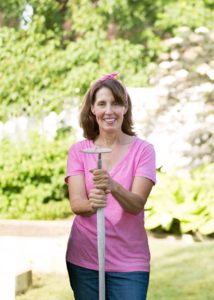
GARDEN WITH COMFORT, EASE AND SIMPLICITY
Jan Bills, who runs the landscaping business Two Women and a Hoe, was our August 2018 speaker. She began her talk by saying, “If I woke up in the morning and nothing hurt, I would think I was dead.” She wants us to love our gardens and not just labor in them. We should not run ourselves ragged striving for perfection but sustainably choose our plants for our climate, site and resources. We need to plan for minimal inputs of water and maintenance.
We should use garden design principles with the above rules in mind. Never forget the old saw: “Right plant right place.” Plant the garden using odd numbers of plants so it is pleasing from every angle. The view from inside the house is especially important in our Michigan climate because we are cooped up inside during the winter months. Plant for winter interest: peeling bark, evergreens, boulders, bird houses, and textural elements, etc. Curvy bed lines are functional and sexy as well as aesthetically pleasing. Mass plantings make a big impact. Jill showed us some pictures of houses with big overgrown shrubbery in the front to illustrate the point that an entrance should be welcoming. When planting around the house, leave room for a maintenance alley – enough room to put up a ladder to paint, clean gutters, etc.
Jill gave us a list of plants she loves including ninebark (give it enough room), black lace elderberry and various hydrangeas like vanilla strawberry, limelight and little lime, bobo, incrediball, invincibelle wee white and tiny tuff stuff. Spilled wine weigela (very compact), drift roses and dwarf fothergilla topped out the list.
Make a list BEFORE you go to the nursery (impulse buying? – we never do that!) and inspect plants before you buy. Blackened areas and holes tell you not to buy. Inspect the roots – if they are growing out the bottom of the pot (too big) or not fully rooted in the pot (too small), pass up the plant.
Leave leaves in the garden to rot down during the winter and provide food and shelter for wildlife. They will fertilize the soil, suppress weeds and protect plant roots for the winter. Sedums and cone flowers and other perennials left standing provide food for the birds and winter interest for the gardener.
There are five deadly sins in the garden: bindweed, chameleon plant, bishop’s weed, Canada thistle and grass. Jill recommends solarization to get rid of infestations of these pests. Solarization is achieved by putting down plastic to heat up the soil in the sun and kill the plants and the seed bank. Some people object to this method because it also kills the microorganisms, worms and other life which are beneficial to the soil. Cardboard is an environmentally friendly weed barrier which adds nutrients to the soil and smothers weeds. Organic weed killer: 1 gallon vinegar, 2 cups Epsom salts, ¼ cup dish soap.
Jill flashed a picture of a possum on the screen and called it nature’s clean-up crew because it eats ticks, insects, snails, small rodents and various kinds of dead stuff. A fun possum story: I was watching a possum and a huge raccoon twice its size eating seeds under the bird feeder on my deck. They were a few feet apart, but suddenly the possum took a running start and rammed his head into the raccoon’s head. I wondered what would happen next, but the raccoon just moved over and continued eating as if nothing had happened. The possum got more seeds.
She ended her talk with two quotes worth remembering:
“If we kill off the wild, then we are killing a part of our souls.” Jane Goodall
“Play in the dirt because life is too short to always have clean fingernails.”
I know why someone called gardeners “green thumbs.” My right thumbnail is green all summer from deadheading and pruning when the scissors and pruners are in the garage.
Jean Gramlich
